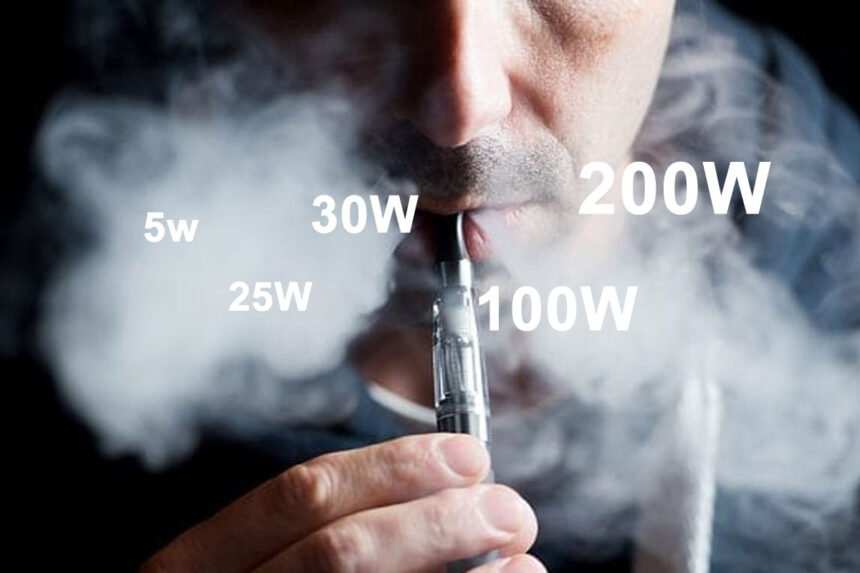Choosing the correct wattage for your vape is a critical factor that can significantly enhance your vaping experience by providing the right balance of flavor, vapor production, and throat hit. This decision, however, can be daunting, especially for new vapers. It’s important to understand that the “ideal” wattage varies widely depending on several factors including the type of device, the coil resistance, the vape juice used, and personal preference.
Understanding Wattage in Vaping
Wattage in the context of vaping is the amount of power used by the device to heat the e-liquid into vapor. It’s a measure of the energy output per second from the battery to the coil, and it directly affects the temperature of the coil. The right wattage makes the coil hot enough to vaporize the liquid but not so hot that it causes dry hits or burns the liquid.
Factors to Consider When Choosing Vape Wattage
Type of Vape Device:
- Low-powered devices such as pod mods are typically used at lower wattages (10-15W). They are suitable for high-resistance coils (above 1 ohm) and provide a discreet amount of vapor and a milder throat hit.
- High-powered devices like box mods are capable of operating at much higher wattages (50W and above). These are suitable for low-resistance coils (sub-ohm coils) and are preferred by users looking for intense flavors and large vapor clouds.
Coil Resistance:
- High-resistance coils (above 1 ohm) generally require lower wattages. They are ideal for mouth-to-lung (MTL) vaping, where the vapor is first drawn into the mouth and then inhaled into the lungs. This style is similar to how one might smoke a traditional cigarette.
- Low-resistance coils (below 1 ohm, often called sub-ohm) require higher wattages. These are preferred for direct-to-lung (DTL) vaping, which involves inhaling the vapor directly into the lungs, producing larger clouds and more intense flavors.
E-Liquid:
- High PG (Propylene Glycol) liquids tend to vaporize at lower temperatures and are best used at lower wattages. They provide a stronger throat hit and are clearer in flavor.
- High VG (Vegetable Glycerin) liquids are thicker, require higher temperatures to vaporize, and are best vaped at higher wattages. They produce denser vapor and are smoother on the throat.
Personal Preference:
- Some vapers might prefer a cooler vape with less vapor, and others might prefer a warmer vape with dense vapor. Experimentation is key in finding what wattage provides the best experience for your taste and preference.
Recommended Wattage Ranges
- 1.0 – 1.8 ohms: Ideal for MTL vaping at wattages between 10W to 15W.
- 0.5 – 0.9 ohms: Suitable for both MTL and restricted DTL, typically vaped between 15W to 35W.
- 0.1 – 0.4 ohms: Commonly used for full DTL vaping, these coils work well from 40W up to 100W or more, depending on specific coil design and user preference.
Adjusting Wattage for Optimal Performance
The right wattage for your vape can also depend on the specific coil you are using. Many coils will have a recommended wattage range printed on them. This range is a good starting point when setting up your device.
- Start low: Begin at the lower end of the recommended wattage and gradually increase it until you find your sweet spot. This helps to prevent premature coil burnout and ensures a pleasant vaping experience.
- Adjust according to taste: If the vapor is too hot or the flavor seems burnt, turn down the wattage. If the vapor production is too weak, increase the wattage slightly.
Safety Considerations
Vaping at wattages that are too high for the coil’s resistance can lead to burnt coils and unpleasant dry hits. It can also stress the battery more than necessary, potentially leading to safety issues. Always ensure that your device’s battery can handle the discharge rate required for the wattage at which you are vaping.
Conclusion
Choosing the correct wattage for vaping is not just about chasing clouds or maximizing flavor; it’s about finding the perfect balance that suits your vaping style and preferences while ensuring safety and coil longevity. By understanding the relationship between coil resistance, e-liquid properties, and wattage, you can tailor your vaping experience to be as enjoyable and satisfying as possible.
